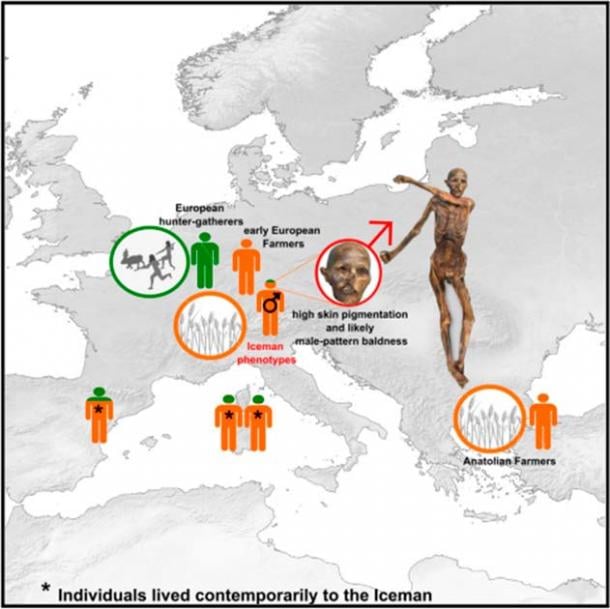
Ötzi the Iceman Genes Trace to Early Anatolian Farmers, and He Had a Receding Hairline
The world’s oldest Alpine celebrity, fodder for many different kinds of studies and analyses over the years since his discovery on the mountainous border between Austria and Italy in 1991, ‘Ötzi the Iceman’, is the subject of a fascinating new study. The Neolithic Tyrolean mummy has been subjected to a high-coverage genome study and the results have thrown up some surprises, including unusually high Anatolian farming ancestry, dark skin, dark eyes, and a balding head!
“The genome analysis revealed phenotypic traits such as high skin pigmentation, dark eye color, and male pattern baldness that are in stark contrast to the previous reconstructions that show a light skinned, light eyed, and quite hairy male,” said Johannes Krause from the Max Planck Institute for Evolutionary Anthropology, Germany, and one of the authors of the study. “The mummy itself, however, is dark and has no hair.”
The study on the world’s oldest glacier mummy has been published in the latest edition of Cell Genomics and is an international collaboration of a number of researchers and scientists from across the world. The research suggests that Ötzi's appearance during his lifetime closely resembled his current mummified state.

The Tyrolean Iceman is known as one of the oldest human glacier mummies. (Südtiroler Archäologiemuseum/EURAC/Marco Samadelli-Gregor Staschitz/Cell Press)
Insulated Alpine Populations, Otzi the Iceman genes, a Genetic Anomaly?
The advanced and thorough genome analysis revealed a remarkable aspect: Ötzi possessed an unusually substantial early Anatolian farmer ancestry. This genetic heritage surpasses that of any other known European population from the 4th millennium BC, pointing to a distinct genetic lineage. This revelation provides compelling evidence that Ötzi was part of an Alpine community characterized by isolation, with limited genetic intermingling with contemporary hunter-gatherer groups, north and west of the Alps in particular.
- 5,300-Year-Old Otzi the Iceman Was Wearing Clothing from Five Separate Animal Species
- New DNA Study Suggests African Humans Interbred With European Neanderthals Way Earlier Than We Think
With over 92 percent of his ancestry traced back to early Anatolian farmers, the discovery underscores the intricate migratory history of European populations. Moreover, it signifies the imposing role the Alps played in acting as a genetic barrier.

Graphic of key findings of the study linking Ötzi genes to Anatolian farmers. (Wang et al. /Cell Press)
Previous genetic affinities between Ötzi and contemporary Sardinians were initially established based on a limited sample size of available human genomes. However, the present research, led by esteemed scholars such as Krause and Albert Zink from Eurac Research – Institute for Mummy Studies in Bolzano, Italy, harnessed advanced sequencing technologies to meticulously analyze Ötzi's genome afresh, resulting in a refined dataset.
“The most surprising results were the presence of male-pattern-baldness-related alleles supporting the absence of hair observed on the actual mummy and the rather dark skin pigmentation that is also supported by the mummy,” explained Zink. “It is remarkable how the reconstruction is biased by our own preconception of a Stone Age human from Europe,” added Krause.
It continues to remain unclear whether the Iceman was a representative of his people and age and geographical territory, or whether he was a genetic anomaly. Further research is needed to corroborate a lot of these findings.
Ötzi: A Figure of Mystery and Intrigue
The Tyrolean Iceman stands as a paramount figure among ice mummies, boasting unparalleled preservation and a distinction as the oldest known specimen – 5,300 years old! Over the years, researchers have ardently pursued insights into Ötzi's identity, including comprehensive genomic and ancestral investigations. A prior study conducted in 2012 yielded valuable insights despite the challenge of DNA contamination from present-day sources.
In 1991, while hiking in the Ötztal Alps, a mountain range straddling Austria and Italy, two German tourists made a remarkable discovery. They came across the frozen remains of a deceased man, exceptionally well-preserved by the ice, with his clothing and tools too that had been remarkably spared from decomposition, reveals a Discover Magazine report.
Given the name Ötzi the Iceman, this extraordinary find ignited a fervent interest among scientists who embarked on an extensive study of the naturally-preserved mummy. Initially thought to have been a deceased tourist from the past couple of centuries, it was revealed that this mummy was from the Copper Age, dating back to around 3300 BC.
Since then, a few interesting facets about Ötzi have emerged, it is believed that he had brown eyes, lactose intolerant (common amongst his contemporaries), had a genetic predisposition to coronary heart disease and was likely in his 40s at the time of passing. He also had blackened lungs due to overexposure to warming next to open fires.
- The Mungo Man fossil Which Challenged out of Africa theory
- Artist Recreates Tattoos of Ötzi the Iceman in Her Own Blood
Finally, he likely died due to either two fresh wounds that were revealed on his body, or a violent snowstorm. Ötzi’s life and death remain a source of fascination and mystery for scientists and historians alike, who hope to learn more as newer studies and research emerge.
Top image: New study challenges what was initially believed about 5,300-year-old Ötzi the Iceman genes. (Inset: The Ötzi mummy) Source: OetziTheIceman/CC BY-NC-ND 2.0 (Inset; Cell Press)
By Sahir Pandey
References
Luchessi, E. 2023. Who Was Ötzi the Iceman? Available at: https://www.discovermagazine.com/the-sciences/who-was-oetzi-the-iceman.
Wang, K. et al. 2023. High coverage genome of the Tyrolean Iceman reveals unusually high Anatolian Farmer ancestry. Cell Genomics, 3. Available at: 10.1016/j.xgen.2023.100377.















